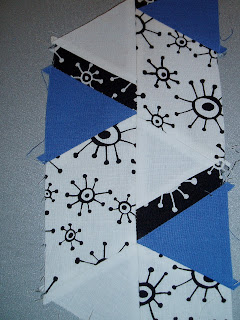4/3/13
HINTS FOR PIECING CONDIMENTS BLOCK
Marny and I are following up our Picnic with tutorials that will be helpful, just in case you run into a snag. A couple of issues have arisen with the Condiments block so I'll fast forward (and then we'll return in order of appearance). These are issues that I did not incur while designing or testing so trying to recreate the challenge is challenging.
It would be good to run a test of this section of the block before proceeding with the entire block. Seam allowances, cutting and pressing practices could make a difference in how these intersections match up.
 |
| Cut and layout three box portions as illustrated. |
When cutting the angles and sizes, pay close attention to the measurements. I found that when I established my angle and added the second ruler to the left side (to allow cutting from the right), I accidentally added a very small amount to that measurement. The reverse could also occur with subtracting just a fraction of an inch. Just be aware.
I've arranged the "cuts" according to the directions, keeping in mind that these come from two different strip set widths. Follow the measurements carefully using the appropriate techniques illustrated in the book. This is just a section of the total block. The issue of matching comes into play when the blocks are staggered.
It's the staggered edge ( here in the center) that is the challenge. Once these fit together, the other sides will sew into place as the match will be more obvious ( triangle to triangle, lid to lid, box to box). You will only need to sew these two strips to test out the fit.
 |
Sew these pieces together as described in the directions,
maintaining the points and pressing open. |
Once the two strips are completed, place them ride sides together to determine the intersection match.
 |
The pin on the right lines up directly under the matched intersection.
The pin on the left is short of the goal so we are going to punt.
|
The intersections don't align correctly so the adjustment is to decrease the larger "box" measurement. In this case, there appears to be about a 1/4" difference so we will trim off 1/4" of the "box"...remembering that it will have to done to all the same sized pieces. Disconnect the pieces very gently as they are bias edges, press and trim down.
 |
| Trim the piece the determined measurement (in this case, 1/4" ). |
Resew the pieces together, press gently and place right sides together to check for alignment.
 |
| The bottom strip is below to show the match. |
Align the edges, match the points, sew and press open.
So the fit of this staggered strip set is much better. If the measurements on the test run are closer, they may be "eased" to fit but obviously, a 1/4" is to much to ease and it will be necessary to trim the piece size.



















Looks like a book I would love!
ReplyDeleteThis is a great book of patterns! Easy to follow and fun to make! Thanks yall!
ReplyDelete